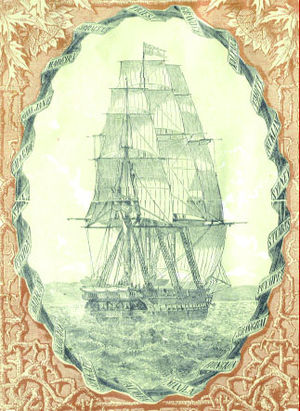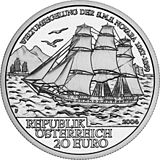- SMS Novara (1850)
-

Image of frigate Novara from expedition report Voyage of the Austrian Frigate Novara around the Earth (1861–1876), published in 21 volumes written over 15 years.Career 
Name: SMS Novara Builder: Venetian Arsenal, Venice Laid down: 20 September 1843 Launched: 4 November 1850 Completed: June 1851 Decommissioned: Hulked, 22 August 1876 Reclassified: Gunnery training ship, 22 June 1881 Struck: 22 October 1898 Fate: Scrapped, 1899 General characteristics as reconstructed in 1862 Type: Screw frigate Displacement: 2,615 t (2,574 long tons) Length: 76.79 m (251 ft 11 in) Beam: 14.32 m (47 ft 0 in) Draft: 5.8 m (19 ft 0 in) Installed power: 1,200 ihp (890 kW) Propulsion: 1 shaft, 1 steam engine Speed: 12 knots (22 km/h; 14 mph) Range: 3,300 nmi (6,100 km; 3,800 mi) at 10 knots (19 km/h; 12 mph) Complement: 550 Armament: 4 × 60-pounder smoothbore Paixhans guns
28 × 30-pounder Novara guns
2 × 24-pounder Breech-loading gunsSMS Novara was a sail frigate of the Austro-Hungarian Navy most noted for sailing the globe for the Novara Expedition of 1857–1859 and, later for carrying Archduke Maximilian and wife Carlota to Vera Cruz in May 1864 to become Emperor and Empress of Mexico.
Contents
History
Service
The SMS Novara[1] was a frigate that circumnavigated the earth during the Austrian Imperial expedition of 1857–1859, under the reign of (Kaiser) Emperor Franz Joseph I. [2] [3] It was a sailing ship with three masts of sails and six decks, outfitted with 42 cannons, and had a water displacement of nearly 2,107 tons.[3]
The SMS Novara during 1843–1899 carried several names and configurations: [4] originally named Minerva when the lengthy construction started in Venice during 1843, the partially completed frigate was renamed Italia by Venetian revolutionaries in 1848, finally launched with the name Novara in 1850, and converted to a steam cruiser during 1861–1865.
The frigate had been renamed after the Battle of Novara (1849): following the Austrians' retaking of Venice, Field Marshal Radetzky visited the shipyard there, and the officers petitioned him to have the nearly-completed Italia renamed in honour of his victory over King Charles Albert at the Italian town of Novara.[4] The ship was subsequently christened "Novara" in 1849, and construction restarted in earnest under Austrian supervision. The hull left the slipway the following year, in November 1850.[4]
The circumnavigation of the earth from April 1857 through August 1859[4] by the Novara was one of the most important journeys for what became the Naturhistorisches Museum in Vienna.[2] A number of eminent natural scientists joined the voyage, including Georg Ritter von Frauenfeld, curator in the invertebrate department of the Imperial museums.[2] The material collected during the expedition was voluminous and continues to be examined and published by prominent scientists up until the present time;[2] (see details below).
Novara Expedition
The Novara Expedition (1857–1859) [3] was the first large-scale scientific, around-the-world mission of the Austrian Imperial war navy. [5] Authorized by Archduke Maximillian, the journey lasted 2 years 3 months, from 30 April 1857 until 30 August 1859.[3]
The expedition was accomplished by the frigate Novara, under the command of Kommodore Bernhard von Wüllerstorf-Urbair,[5] with 345 officers and crew, plus seven (7) scientists aboard.[3] Preparation for the research journey was made by the "Imperial Academy of Sciences in Vienna" and by specialized scholars under direction of the geologist Ferdinand von Hochstetter and the zoologist Georg von Frauenfeld.[5] The first coca plant (cocaine) investigations, in particular on St. Paul Island, the Nicobar Islands, and on New Zealand (first geological mapping by Hochstetter), created the bases for future geological research.[5] The oceanographic research, in particular in the South Pacific, revolutionized oceanography and hydrography.[5]
The collections of botanical, zoological (26,000 preparations), and cultural material brought back enriched the Austrian museums (especially the natural-history museum).[5] They were also studied by Johann Natterer, a scientist who collected Vienna museum specimens during 18 years in South America. The geomagnetic observations made throughout the whole expedition significantly increased the scientific knowledge in this field.[5] Finally, the expedition's introduction of coca plant leaves made it possible to isolate cocaine in its pure form for the first time in 1860.[5]
The results of the research journey were compiled into a 21-binder report of the Viennese Academy of Sciences, titled "Reise der österreichischen Fregatte Novara um die Erde (1861–1876)" ("journey of the Austrian frigate Novara around the earth"). Also published were many woodcuts under the same title (in 3 volumes, by K. Scherzer 1864–1866).[5]
The Novara-Expedition report included a drawing of the frigate SMS Novara surrounded by an oval border with the names of locations visited: Gibraltar, Madeira, Rio de Janeiro, Cape Town, St. Paul island, Ceylon, Madras, Nicobar Islands, Singapore, Batavia, Manila, Hong Kong, Shanghai, Puynipet island, Stuarts, Sydney (5 November 1858), Auckland, Tahiti, Valparaíso, Gravosa, and Triest (returning on 26 August 1859).
Voyages with Archduke Ferdinand Maximilian
In April 1864, the SMS Novara had the important task of carrying Archduke Maximilian and his wife Charlotte to Vera Cruz, in the Americas, for their establishment as the new Emperor and Empress of Mexico during the Second Mexican Empire. The Novara arrived at Vera Cruz, Mexico on 28 May 1864.[2]
Over 3 years later, upon the capture and execution of Maximilian I of Mexico, by the revolutionary Mexican government (of Benito Juárez), Admiral Wilhelm von Tegetthoff was sent with the Novara to bring Maximilian's body home to Austria, arriving in the port of Trieste on 16 January 1868.
Battle of Lissa
SMS Novara saw active service during the Battle of Lissa which took place on 20 July 1866 in the Adriatic Sea near the island of Vis (Italian: Lissa). SMS Novara belonged to Admiral Wilhelm von Tegetthoff's 2nd Division which consisted mainly of wooden steam warships. The battle was a decisive victory for an outnumbered Austrian Empire force over a superior Italian force. It was the first major sea battle between ironclads and one of the last to involve deliberate ramming.
Legacy
SMS Novara has left such a legacy behind that it was selected the main motive for a very recent commemorative coin: the 20 euro S.M.S. Novara coin minted in 16 June 2004. The obverse shows the frigate SMS Novara under sail during her circumnavigation of the globe in 1857-1859. The Novara was the first Austrian ship in the Austro-Hungarian Navy to circumnavigate the world. In the background, there is a representation of the Chinese coast. Seagulls, showing the nearness to land, circle the ship.
See also
- SMS Novara for ships of the same name.
- Imperial Natural History Museum, predeceding institution of the Naturhistorisches Museum.
- European and American voyages of scientific exploration
Notes
- ^ In German for ship names, "SMS" means Seiner Majestät Schiff ("His Majesty's Ship"). See more at: Kaiserliche Marine.
- ^ a b c d e "The Crustacean Collection of the Museum of Natural History in Vienna" (history), Peter C. Dworschak & Verena Stagl, 3rd Zoological Dept., Naturhistorisches Museum, Vienna, webpage (@www.nhm-wien.ac.at): NHM-Wien-Crustacean-PDF.
- ^ a b c d e "Novara-Expedition" (port-by-port description), Kunsthistorisches Museum Wien, 2005, webpage: KHM-Novara-Expedition.
- ^ a b c d "The Austrian Imperial Frigate SMS Novara" (history + photos), Michael Organ, 25 October 2006, Australian webpage (@MichaelOrgan.org.au): MOrgan-Novara1.
- ^ a b c d e f g h i "Novara-Expedition" (description), German Wikipedia, 2006-10-29, De.Wikipedia.org webpage: DeWiki-Novara-Expedition.
References
- "Embarkation of the Body of the Late Emperor Maximillian at Vera Cruz, Mexico", The Illustrated London News, 11 January 1868, p. 32 [with an engraved view of the SMS Novara and HMS Niger].
- Treffer, G. (ed.), Die Weltumseglung der Novara, 1857-1859 ("The Round-the-World Voyage of the Novara"), Molden, Vienna, 1973, 224p.
- Turner, Brian, "Novara: Austria's Ship of Fate" from "Heligoland Bight - Wooden Ship's Last Sea Battle (9 May 1864)" in Military History, February 1997, pages 54–61.
External links
Categories:- Exploration ships
- French intervention in Mexico
- Frigates of the Austro-Hungarian Navy
Wikimedia Foundation. 2010.


